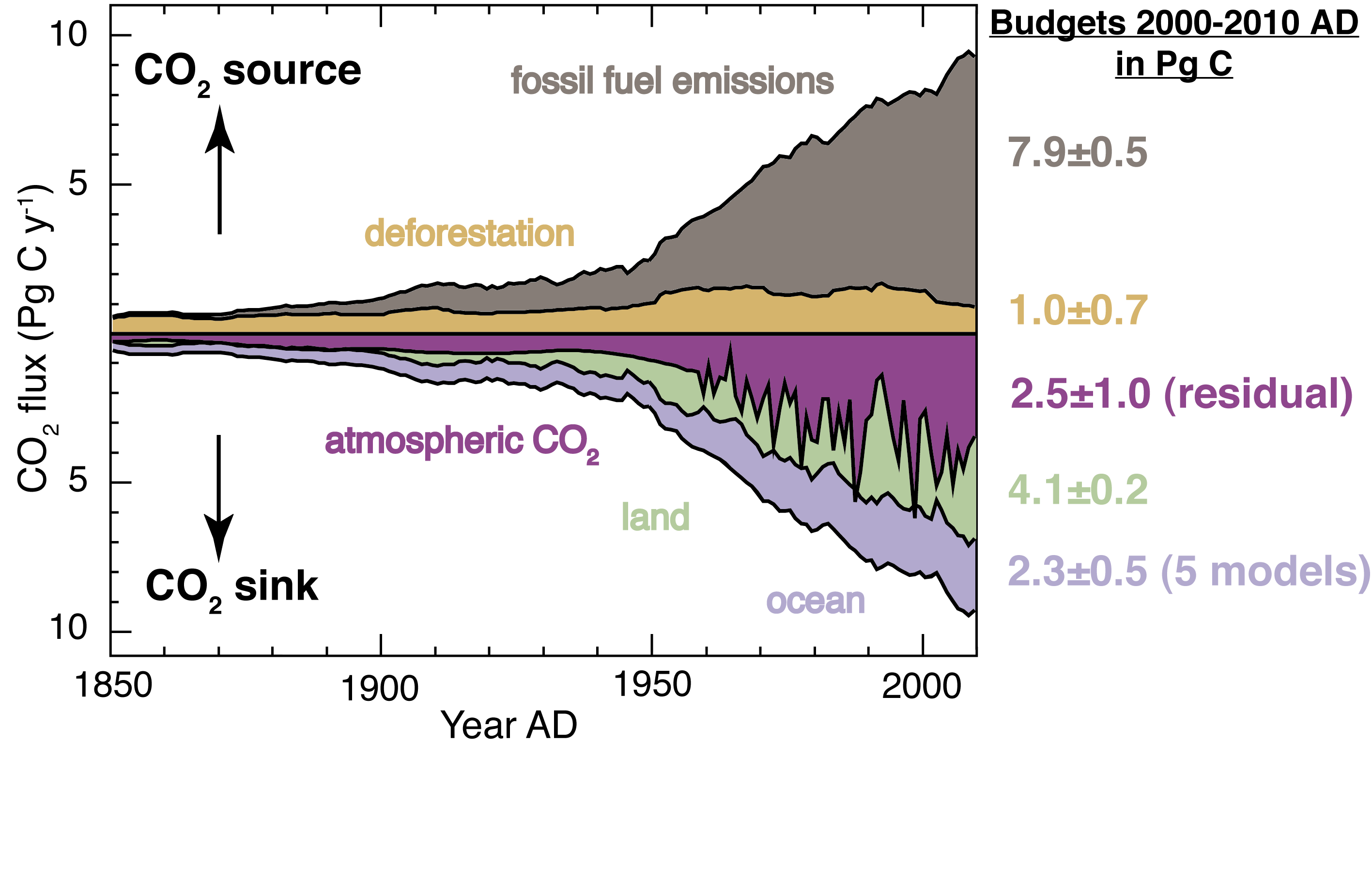- Home
- Publications
- PAGES Magazine
- Carbon Cycle Dynamics - How Are Major Carbon Sinks and Sources Varying With Global Change? [Present]
Carbon cycle dynamics - How are major carbon sinks and sources varying with global change? [Present]
David Schimel
PAGES news
20(1)
12
2012
David Schimel
National Ecological Observatory Network, Boulder, USA; dschimel neoninc.org
neoninc.org
The entire Earth System, atmosphere, oceans, biology and geology are involved in the carbon cycle (Archer 2010). Carbon dioxide is taken up by the land biosphere through photosynthesis, and released through respiration and combustion (Schimel et al. 2001). The oceans take up carbon through closely coupled physical, chemical and biological processes (Sarmiento and Gruber 2006). They absorb carbon dioxide in regions where mixing and biological activity maintain low ocean carbon dioxide levels, allowing chemical diffusion from these active regions of the sea. In other regions, carbon-rich water mixes to the surface and releases carbon to the atmosphere. These processes are natural and have always occurred.
The anthroposphere, the sphere of human activities, transforms this cycle in two ways. First, humans burn carbon from geological reservoirs that would normally be stable over millions of years and introduce this additional carbon into the more active atmosphere-ocean-land system, increasing the total amount of carbon circulating in the Earth System (Archer 2010). Second, human land use converts biologically stored carbon in soils and plants to carbon dioxide in the atmosphere, changing the balance of stored and circulating carbon (Schimel 1995).
These human activities increase atmospheric carbon dioxide and thereby the trapping of heat in the atmosphere, leading to global climate change. As climate changes, it has consequences for the carbon cycle. The rates of many biogeochemical processes, such as photosynthesis, respiration, nitrogen cycling and wildfire increase in warmer conditions (Field et al. 2007). These higher process rates may speed up biological activity, producing potential positive and negative feedbacks to the carbon cycle. In some models, the feedback effects of the carbon cycle influence atmospheric CO2 by tens to even hundreds of parts per million, corresponding to significant effects on temperature (Cox et al. 2000). Temperature effects may be largest in high latitude regions, where enormous post-glacial deposits of carbon in permafrost could be released as CO2 and methane as these soils thaw (Koven et al. 2011).
Precipitation also changes as the warming atmosphere causes more evaporation. This intensification of the hydrological cycle will cause some regions to become wetter, but arid regions may become drier. Drier conditions in the tropics will decrease plant growth and reduce carbon storage in these regions (Fung et al. 2005). Warmer and wetter conditions in mid-latitude regions may actually increase carbon storage. Most evidence suggests the tropical effects are larger, leading to overall release of ecosystem carbon stores. This creates a global feedback increasing atmospheric carbon dioxide as temperatures warm.
When humans burn fossil fuels, they transform organic carbon compounds that last for millions of years into atmospheric carbon dioxide. The uptake and stabilization of carbon dioxide into long-lived carbon compounds – which defines the lifetime of carbon dioxide – takes a lot of time. While photosynthesis and air-sea gas exchange can draw CO2 concentrations down quickly, i.e. within years, actually transferring that carbon into stable chemical forms, safe from recycling back to the atmosphere requires ten to thirty thousand years (Archer 2010).
Because of the long lifetime of changes to the carbon cycle, the paleo-perspective is critical. For example, paleorecords tell us that while atmospheric carbon dioxide concentrations can increase quite rapidly, it can take much, much longer for it to be locked into long-lasting forms and provides a timescale for these dynamics. During one well-documented event 55 million years ago, atmospheric carbon dioxide nearly doubled over about 20,000 years, with an accompanying increase in temperature of perhaps 6°C. While atmospheric carbon dioxide increased very rapidly, it took nearly 7-8 times longer to return to previous levels (Doney and Schimel 2007).
Carbon scientists are finding creative ways to combine paleodata, process studies and modern-day observations to model the ”fast out-slow in” processes that determine the longevity and severity of climate change. The paleorecord provides an essential observational basis for assessing the reality of model-based scenarios of the long-term future.
references
Full reference list online under: http://pastglobalchanges.org/products/newsletters/ref2012_1.pdf
Archer D (2010) The Global Carbon Cycle (Princeton Primers in Climate), Princeton University Press, 224 pp
Doney SC and Schimel DS (2007) Annual Review of Environment and Resources 32: 31-66
Cox PM et al. (2000) Nature 408: 184-187
Fung IY, Doney SC, Lindsay K and John J (2005) PNAS 102: 11201-11206
